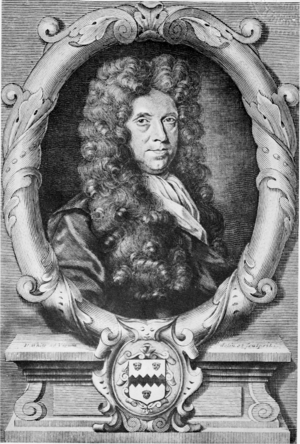Nehemiah Grew facts for kids
Quick facts for kids
Nehemiah Grew
|
|
|---|---|

Nehemiah Grew
|
|
| Born | 26 September 1641 Mancetter Parish, Warwickshire
|
| Died | 25 March 1712 (aged 70) London
|
| Nationality | English |
| Alma mater | Leiden University |
| Scientific career | |
| Fields | Physiology |
Nehemiah Grew (born September 26, 1641 – died March 25, 1712) was an English scientist. He studied plants and how they are built. Many people call him the "Father of Plant Anatomy." This means he was one of the first to study the inside parts of plants.
Grew went to Pembroke College, Cambridge in England. He finished his studies there in 1661. Ten years later, he earned his degree as a medical doctor from Leiden University in the Netherlands.
Contents
Discovering Plant Secrets
Nehemiah Grew started studying plants in 1664. He wanted to know how they were made. In 1670, he wrote an important paper. It was called The Anatomy of Vegetables begun. He shared this paper with the Royal Society. This is a famous group of scientists in London.
The Royal Society liked his work. In 1671, they made him a member. A year later, his paper was published. Grew then moved to London. He became a successful doctor there.
Grew's Important Books
In 1673, Grew published another book. It was called Idea of a Phytological History. This book also shared his ideas about plants. He had presented these ideas to the Royal Society before.
Later, in 1677, Grew became the Secretary of the Royal Society. This was an important job. He helped publish scientific papers for the group.
Anatomy of Plants: A Big Book
Grew's most famous book came out in 1682. It was called Anatomy of Plants. This book brought together many of his earlier studies. It had 82 detailed pictures of plants. These pictures showed what plants look like inside.
This book was special because it described plant parts very well. Grew showed how stems and roots are different. He also explained that flowers like daisies are made of many small parts. He correctly said that stamens are the male parts of a flower. His book also had the first close-up look at pollen using a microscope.
Working with Microscopes
Nehemiah Grew used a microscope a lot. He looked at tiny parts of plants. Another scientist named Marcello Malpighi was doing similar work. They both learned from each other.
Grew's work on pollen was very detailed. He found that pollen grains look different for each type of plant. But all pollen from the same plant type looks alike. This discovery was very important. It helped create a field of study called micropaleontology. This science looks at tiny fossils, often including ancient pollen.
See also
 In Spanish: Nehemiah Grew para niños
In Spanish: Nehemiah Grew para niños

